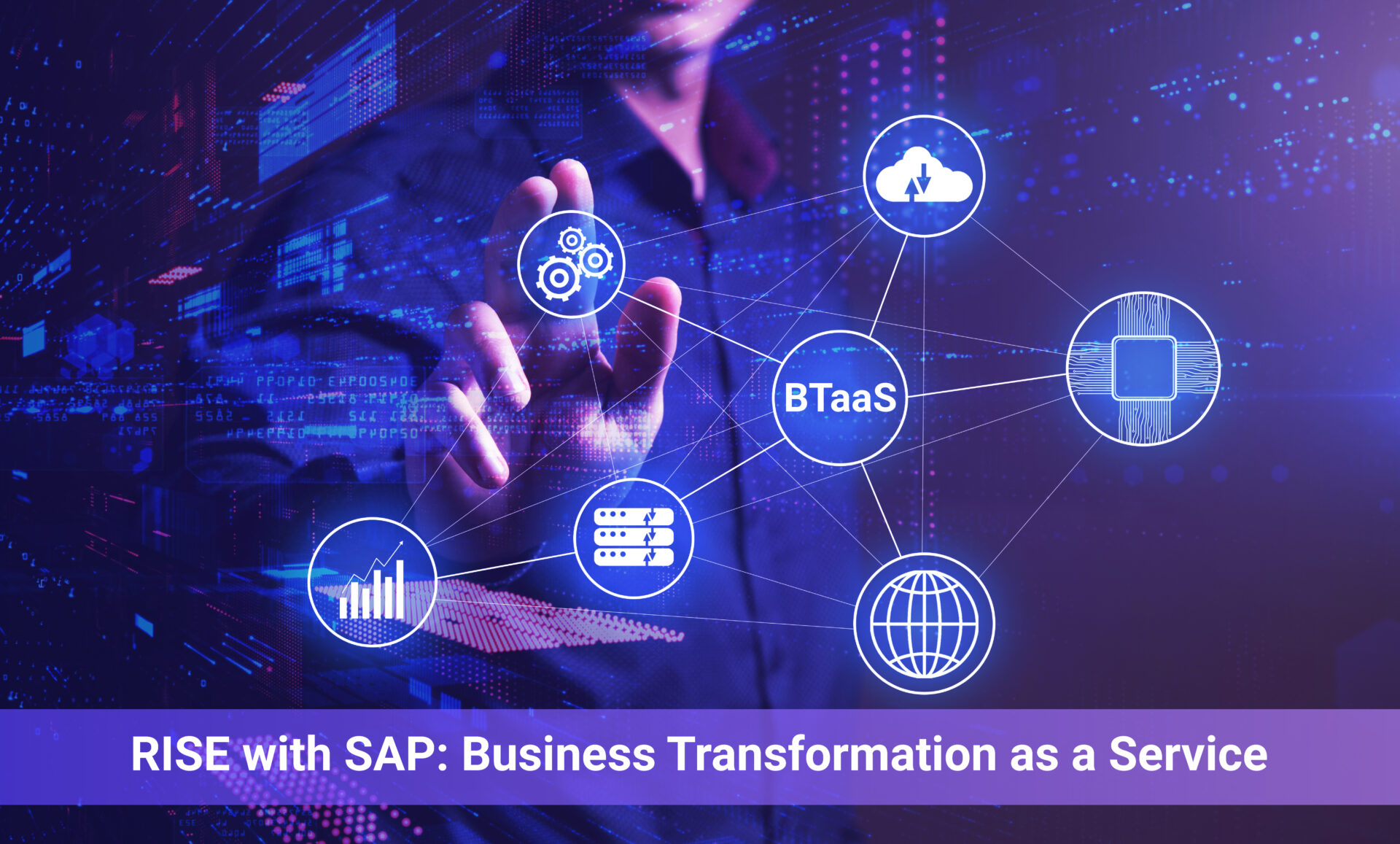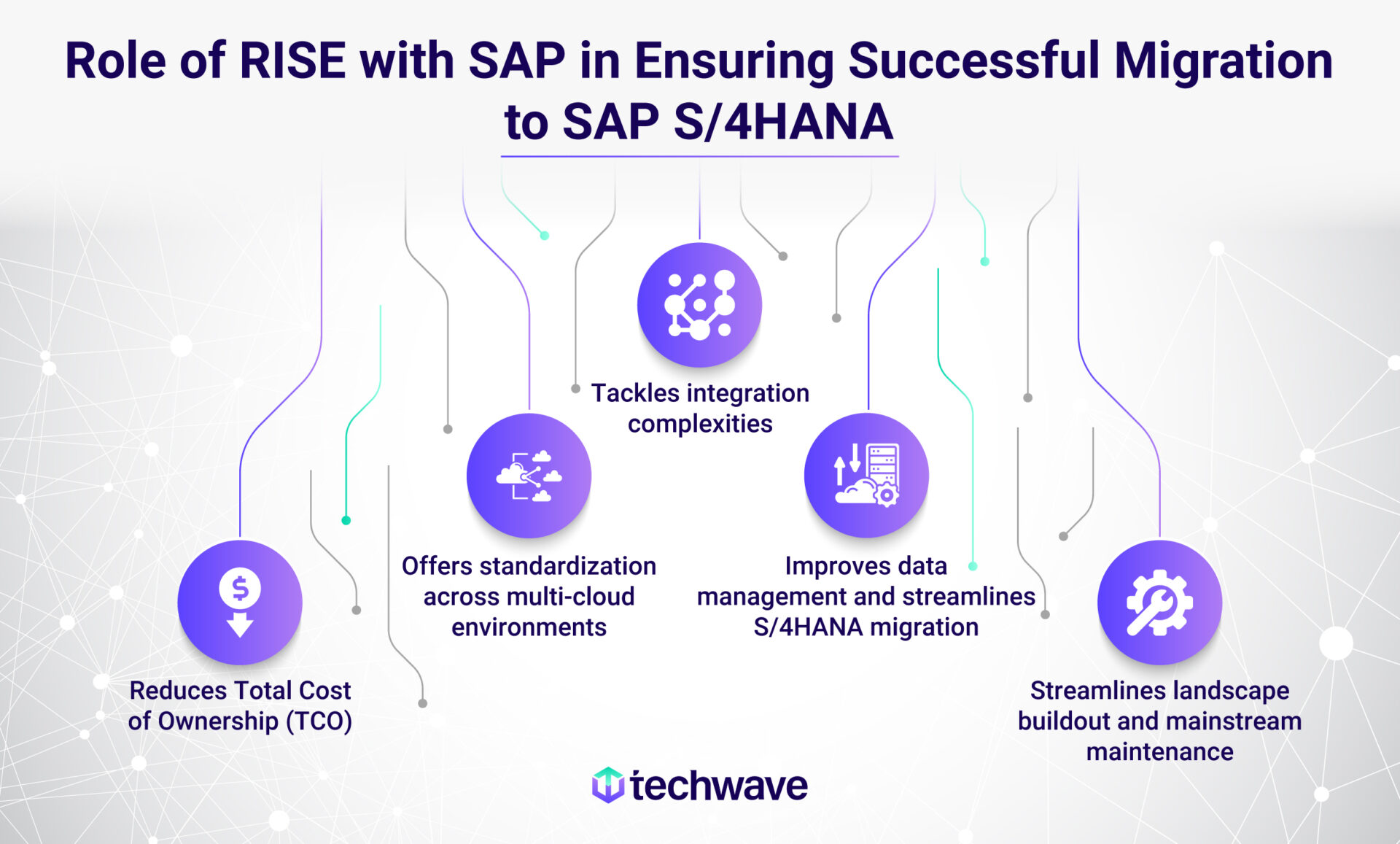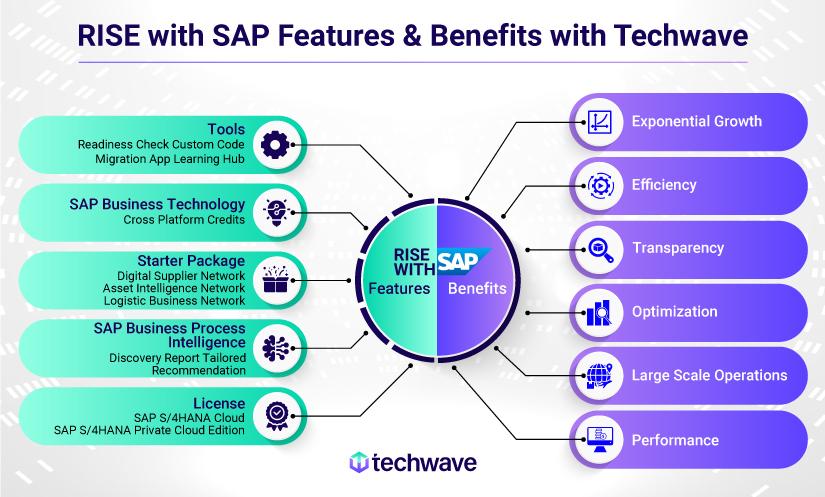
SAP Cloud Migration and its Role in Business Transformation
The volatile economic conditions have created a demand for constant adaptations in decision-making, swift response times, and efficient issue resolution. To do so, businesses strive to find new ways of becoming more agile, intelligent, and efficient. Given the pivotal role of technology in the current landscape, it is imperative for businesses to carefully select and implement the most suitable technology solutions to achieve optimal outcomes. As a result, many business leaders are modernizing their enterprises by leveraging SAP digital core on cloud infrastructure to increase agility, security, and innovation.
As organizations modernize their critical workloads, they crave greater flexibility and options. However, the specific goals and starting points for this transformation vary. Some aim to enhance operations by transitioning from legacy ERP to SAP S/4HANA; some are still running on ERP Central Component (ECC) support and are on the fence about transitioning, while others seek to harness AI and automation to replace manual processes.
In SAP’s financial performance Q2 2023 report, SAP’s cloud segment soared with SAP S/4HANA, its flagship product, achieving an impressive 74% revenue growth.
Transitioning to S/4HANA empowers organizations to unlock the complete potential of their data. It harnesses data at a detailed level, enabling real-time actionable insights. Embracing the latest ERP version offers organizations a competitive advantage.
However, postponing the cloud migration to the latest SAP suite can impede the overall SAP transformation journey, causing organizations to lag behind digitally mature competitors in key areas like innovation, competitiveness, and responsiveness.
Given the impending end of support for SAP ECC in 2027, the need to expedite the transition to SAP HANA and S/4HANA is another challenge for SAP users. Unlike earlier, when SAP extended the deadline from 2025 to 2027, it may not provide any extensions this time. Also, the push toward cloud adoption has added to the mounting pressure. This initiative aims to bring about innovations, enhancing aspects such as customizations, data models, user experience, decision-making, and business processes.
Although the migration process may seem like a technical improvement, the complete benefits of S/4HANA can only be unlocked when considering both the shift to cloud infrastructure and the accompanying business transformations like streamlining processes, improving data analytics capabilities, and enhancing overall agility and competitiveness. Moving to the cloud enhances SAP system performance but can be costly if organizations do not address the specific SAP cloud migration challenges associated with running SAP on the cloud.
Converting from SAP ECC to SAP S/4HANA is more intricate and entails technical changes and a shift in application functionality and business processes. Moreover, it depends on the extent of customizations made in the SAP ECC system, which must be adapted to align with SAP S/4HANA requirements.
RISE with SAP: Unified SAP Cloud Migration Solution
Previously, transitioning to the cloud required organizations to navigate complex software licensing agreements with multiple parties, select a hyperscaler, and engage application providers for implementation and management services. This resulted in a protracted decision-making process, increased maintenance expenses, intricate data storage and transfer systems, and limited time for innovation.
To address these challenges, the fast closing-in deadline, and to enable business growth and expansion, SAP offers a comprehensive solution package RISE with SAP that caters to various business needs, all within a single unified platform, meaning ‘One Contract’.
In essence, RISE with SAP is not a new product but a bundled proposition of existing SAP products and services for intelligent enterprises, offering minimal risk without significant upfront investments. Its purpose is to aid organizations in transitioning to SAP S/4HANA Cloud without managing infrastructure while streamlining business processes. Businesses can choose their preferred Infrastructure as a Service (IaaS) provider.
RISE with SAP comprises:
- SAP S/4HANA Cloud (SaaS version)
- Technical managed services
- Business process intelligence
- SAP Business Technology Platform (BTP) and Analytics
- SAP Business Network
According to Gartner, RISE with SAP, the commercial offering by SAP introduced in January 2021, comprises 50% of total SAP S/4HANA sales in the year 2021.
How does RISE with SAP Foster Successful SAP S/4HANA Cloud Migration?
Embarking on Enterprise Planning can be a complex endeavor, as it demands a multitude of processes, software applications, and tools to set in motion. Enterprises can promptly initiate digital transformation efforts by opting for an all-inclusive package like SAP RISE. Let’s delve into how RISE with SAP guarantees a smooth transition to S/4HANA by navigating the following challenges.

Reduces Total Cost of Ownership (TCO)
On average, migrating to SAP HANA or S/4HANA on IaaS costs $1.5 million for consulting and another $1.5 million in terms of business disruption. Moving from a non-SAP database to SAP HANA averages $4.9 million, similar to transitioning from ECC to S/4HANA.
TCO refers to the overall cost incurred throughout the lifecycle of implementing and maintaining the SAP HANA S/4 system. This includes the initial investment in software and hardware and ongoing expenses related to licensing, infrastructure upgrades, training, support, and maintenance. TCO is often higher in SAP HANA S/4 migration due to several factors:
- Initial Investment
- Infrastructure Upgrades
- Data Migration and Transformation
- Integration and Customization
- Training and Skill Development
- Downtime and Business Disruption
TCO for SAP S/4HANA in a private cloud is higher than in the public cloud. The public cloud is recognized for its low operational TCO, as it doesn’t require infrastructure investments or associated costs, reducing IT administrative tasks. It offers swift implementation, accelerated adoption, and deployment, all while ensuring comprehensive data security. However, the private cloud’s TCO is a challenge.
RISE with SAP in a private cloud enhances business responsiveness. Also, it results in a substantial 20% reduction in TCO over five years with decreased staffing and infrastructure costs and faster deployment, proving to be the best SAP cloud solution for climbing TCO in the private cloud.
Offers standardization across multi-cloud environments
One of the primary challenges that SAP customers face when migrating their SAP systems to the cloud and running them is the need for consistent standards. When choosing from the three major Infrastructure as a Service (IaaS) providers—AWS, GCP, or Azure—to deploy and manage SAP systems in the cloud, there are various strengths and potential pitfalls to consider. Each cloud provider offers a range of capabilities and tools, but they may not all be equally enterprise-focused or well-documented.
These inconsistencies in cloud standards can quickly lead to confusion for IT operators or Managed Service Providers (MSPs) tasked with managing a hybrid and/or multi-cloud environment, which is often the case in most SAP migrations to the cloud. Different tools for each environment create confusion and hamper consistent management and monitoring, leading to inefficiencies, failures, and added training and maintenance overhead.
RISE with SAP ensures organizations maintain consistent standards and governance practices across multi-cloud environments. This approach helps organizations harness the flexibility and innovation of multi-cloud while mitigating the complexities and challenges associated with managing diverse cloud providers.
For example, the RISE with SAP package includes access to SAP BTP. SAP Business Technology Platform (SAP BTP) combines application development and automation, data and analytics, integration, and AI capabilities in a unified environment, implying its critical role in a multi-cloud setup.
Usually, insightful data for reporting purposes comes from varied sources like SAP and non-SAP sources, hyperscaler data storage, SAP data warehouse, and SaaS applications such as Salesforce and needs to be merged for analytics. This typically involves a significant amount of manual work.
SAP BTP seamlessly deploys on Azure, AWS, GCP, and similar major cloud providers and can consolidate data from multiple sources. The next step is analysis and presentation through insightful dashboards. Here, SAP Analytics Cloud (SAC) serves as the end-user support tool. So, SAP BTP and SAC collaborate with hyperscalers and other applications to deliver insightful dashboards to end users.
In essence, RISE with SAP signals SAP’s intent to collaborate, not compete, with hyperscale cloud providers.
Tackles integration complexities
Integration scenarios can be complex, involving multiple systems and partners. Third-party applications, legacy systems, and external partners are often part of integration tasks extending beyond SAP.
Data integration is another challenging aspect due to the volume, speed, and diversity of data in SAP systems, making real-time access difficult. The rise in the adoption of interactive business processes has brought unprecedented and overwhelming complexities for organizations, such as managing intricate data flows, and ensuring data security and privacy.
RISE with SAP tackles integration challenges in SAP HANA S/4 cloud migration through several key strategies spanning – a holistic approach, standardization, incorporates partner’s role in the integrations, and data integration with essential tools and services to manage the high volume, speed, and diversity of data in SAP HANA S/4 environments.
SAP hosts Ariba Network, SAP Asset Intelligence Network, and SAP Logistics Business Network (available with a separate license) as cloud-based software services for RISE with SAP customers. These services enable supply chain partners to access up-to-date transactional data and collaborate seamlessly in real-time with complete transparency. This integration benefits various stakeholders, including suppliers, logistics partners, OEMs, asset owners, operators, regulators, and service providers.
For instance, in a manufacturing company, SAP Asset Intelligence Network can automatically provide usage updates of its manufacturing equipment to maintenance partners. This proactive approach allows for the timely procurement of necessary parts and service personnel for predictive maintenance, eliminating the need to wait for reactive maintenance situations.
Improves data management and streamlines S/4HANA migration
In a survey of 116 SAP user organizations, 61 percent reported that data management challenges are currently impeding or will impede the automation of their business processes. Additionally, two-thirds (66 percent) expressed that data management poses challenges during the transition from SAP ECC 6.0 to SAP S/4HANA.
A significant challenge is the substantial amount of data stored in outdated formats. Migrating this extensive legacy data into the SAP Integration Suite can be intricate and time-consuming. SAP systems house and manage millions of transactional data records vital for various business operations within enterprises. Given the central role of data in SAP systems, organizations must ensure that their data aligns with modernization efforts.
Additionally, migrating to SAP S/4HANA in the cloud necessitates significant alterations to business processes. For example, when transitioning from a customer/vendor data model to a more streamlined business partner model, data inconsistencies are highly probable, particularly when creating the data pipeline for conversion.
Data pipelines facilitate data movement, allowing it to flow from applications to data warehouses and data lakes to analytics databases. Data inconsistencies during building a data pipeline refer to discrepancies or irregularities in the data that can occur at various stages of the data pipeline process. These inconsistencies can be format inconsistencies, missing data, duplicate data, etc.
Therefore, exploring a comprehensive solution like RISE with SAP that addresses all your data management requirements is crucial when considering SAP migration.
For example, under certain conditions, such as the customer’s current SAP system version, licensing agreements, readiness assessments, data quality, etc., existing SAP customers can transition to SAP S/4HANA Private Cloud using the brownfield system conversion approach through RISE with SAP. This applies to ECC customers who wish to move to SAP S/4HANA Cloud, Private Edition. In this approach, a business can achieve Selective Data Transition to SAP S/4HANA using the Data Migration & Landscape Transformation (DMLT) option, allowing customers to choose which parts of their data to migrate to SAP S/4HANA. They can select the organization’s master data (like customer and product data), and transactional data (like sales and purchase records) to move to the new system. Throughout this migration process to the cloud, customers can retain their existing functional scope and customizations, allowing them to plan for innovations at their own pace.
Streamlines landscape buildout and mainstream maintenance
In SAP, a landscape buildout refers to setting up and configuring the various system components, environments, and infrastructure required to support SAP applications and solutions. This encompasses the design and creation of the entire IT landscape to ensure that it meets the organization’s development, testing, and production needs.
Go-live marks the moment when the SAP production system becomes accessible to end-users, initiating its active operation.
Mainstream maintenance is a continuous phase that starts after the system goes live and remains in effect throughout the system’s operational life. It encompasses the ongoing support, maintenance, and enhancement of the SAP system in its production environment. It’s the phase where regular system updates, patches, and improvements are applied.
The RISE Limited Maintenance Policy (LMP) is a set of guidelines and rules provided by SAP. It explains how organizations using SAP S/4HANA on-premise software versions with limited or no remaining mainstream maintenance can upgrade to a current software version through RISE Private Edition.
Like any software, SAP S/4HANA receives regular updates, bug fixes, and support from SAP to ensure it runs smoothly and securely as part of the mainstream maintenance. Over time, older versions of SAP S/4HANA may reach a point with limited or no mainstream maintenance.
RISE with SAP Private Cloud Edition allows organizations to upgrade to a current version of SAP S/4HANA automatically.
Why Do You Need an Expert SAP RISE Solutions Provider?
SAP characterizes RISE with SAP as a Business Transformation as a Service (BTaaS) offering, and respondents primarily view RISE with SAP’s role in their SAP S/4HANA projects as a driver of transformation. Understanding what motivates respondents regarding transformation and SAP S/4HANA is crucial for a more comprehensive grasp of RISE with SAP’s impact.
As per data from a November 2021 SAP Insider survey, respondents identified Business Transformation (54%) and Business Responsiveness and Agility (47%) as the key objectives RISE could facilitate. However, it’s worth noting that not all respondents expressed interest in RISE with SAP (10%), and some are not considering it for strategic initiatives (17%). Recognizing that RISE with SAP isn’t a one-size-fits-all solution is essential.
Many SAP customers operate in a mixed landscape of SAP and non-SAP solutions. About 30% of respondents expressed apprehension about project transparency, including ownership and execution details, which are valid concerns. These transparency issues may persist even after SAP cloud migration, affecting responsibilities. RISE with SAP doesn’t eliminate these complexities; they persist and require careful consideration. In capable hands, it’s the best SAP offering to excel in cloud and innovation. To do this, a business must reach out to an expert SAP RISE solutions provider with proven success stories.
Achieve SAP Excellence with Techwave’s RISE with SAP Expertise

As an SAP Gold Partner, Techwave holds SAP Certifications in Cloud and Infrastructure Operations, Hosting Operations, and SAP HANA Operations, which positions us as one of the most reliable and committed SAP service providers worldwide. Our commitment to delivering an exceptional SAP experience includes offering expert and customized services, in-depth knowledge of enterprise-specific requirements, readily available on-site support, and consistent system health assessments. Boost your business’s capabilities and competitiveness by taking advantage of the enhanced features and benefits of Techwave’s RISE with SAP services.
Contact us to learn more about our services and offerings.
